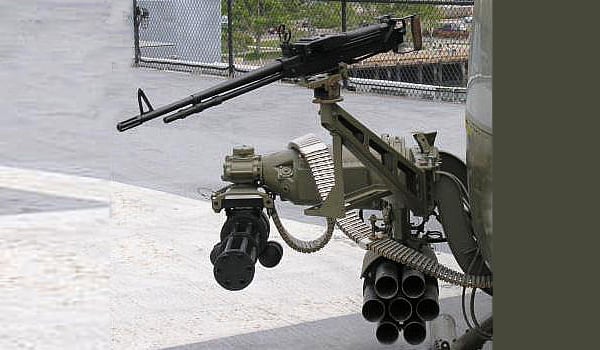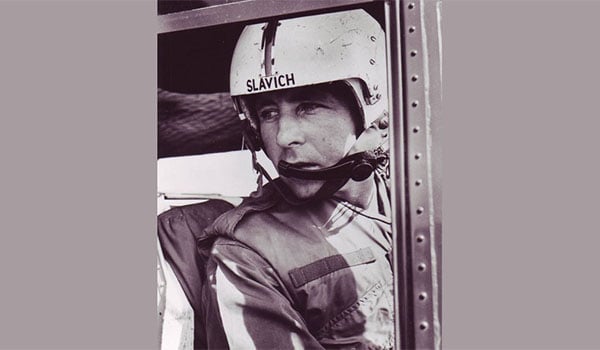
Okinawa, July 25, 1962, the first Army-operated armed helicopter company was formed; a carry-forward from Colonel Jay Vanderpool’s earlier effort, the Aerial Reconnaissance Company. The new unit became known as the Utility Tactical Transport Helicopter Company or UTT. The name itself did not betray what the unit’s mission actually was, so as not to arouse Air Force concerns as to the Army’s intent of muscling in on USAF responsibility for tactical air support; or what it really amounted to, close air support. Because in the end, this is where it was going to go.

UH-1 Huey featuring 2.75-inch rocket pods. Model was billed as a ‘C’ version. But according to serial number 63-8725, model is actually a ‘B’.
In command was Lieutenant Colonel Robert Runkle. The UTT moved to Thailand to commence jungle training. It worked with the Joint Task Force 116 and the 27th Infantry Battle Group for field exercises. And by October 1962, the UTT was in Vietnam, providing armed escorts for the troop carrying CH-21s, ferrying South Vietnamese troops into action against the Viet Cong. From October 1962 to September-October 1963, the UTT logged some 3,280 sorties in 3,558 combat hours.[1]
On October 7, 1962, the 571st Transportation Detachment (Aircraft Maintenance) was attached to the Utility Transport Helicopter Company to service its aircraft.[2]
“Much of the tactical doctrine for armed helicopter employment evolved during this period including the techniques for protective fire preparation for landing zones prior to and during a helicopter assault. The Utility Tactical Transport Helicopter Company was re-designated the 68th Aviation Company and later the 197th Airmobile Company. Its early history was studied intensely by a special group known as the Army Concept Team in Vietnam which was established in Saigon on 6 November 1962.”[3]
Runkle’s crews were flying UH-1A Huey helicopters[4] armed with in-theater weapons systems. Chief Warrant Officer Clarence J. Cutter, formerly a member of Vanderpool’s team at Fort Rucker, joined with CWO Clem Womack, designer of 1st Armored Division’s kits, to arm the UTT aircraft.[5]
On November 21, 1962, Lieutenant Colonel Ivan Slavich replaced Lieutenant Colonel Runkle. Soon after the change in command, UH-1Bs began to arrive, with factory-installed weapons systems.

Machine Gun/Rocket package on a UH-1 gunship.
The XM-6 subsystem was designed for use on the UH-1B “as a fire suppressive deterrent against ground troops and soft target installations. It consists of quad M-60 machine guns, an ammunition feed group, and a fire control system. The guns are armed, traversed, depressed and elevated from the cockpit. Normal ammunition load is 6,000 rounds of 7.62 linked ammunition. Maximum firing rate for this subsystem is approximately 2,000 rounds per minute. Maximum effective range is 1,700 meters. In addition to the quad M-60 machine guns, a locally fabricated 2.75 aerial rocket group is attached to the XM-6 gun mount.”[6]
“The XM-3 subsystem is designed to provide the UH-1B helicopter with firepower against troop concentrations, groups of unarmed vehicles and supply installations. The launcher, fully loaded, carries 48 rockets with high explosive warheads. Rockets may be fired in a single pair or in ripples of pairs. Maximum effective range for the 2.75 inch aerial rockets is 2,500 meters.[7]
1963 was a year of trial and error; for the UTT was an experiment, and one conducted in combat conditions. And the tactics and techniques developed would serve the needs of American Aircav troops once they were deployed to Vietnam.

Lieutenant Colonel Ivan Slavich, second commander of the Utility Tactical Transport Helicopter Company.
The historical parallel here is World War II, when the Field Artillery organized the Air OP[8] for the aerial adjustment of artillery fire. Flying the L-4 Cub, Field Artillery pilots proved able to assume other tasks, such as observation and reconnaissance, route column control, light transportation and even evacuation of wounded. Twenty years later, the UTT was assuming tasks besides that of escorting transport helicopters, such as reconnaissance, convoy protection, close air support of ARVN ground troops. . . [9]
The last named task is of significance, that of fire support of ground troops; a bone of contention between the Army and Air Force for years. UTT, then, was a development within that difference of opinion concerning the Roles and Missions debate; as well as emblematic of the fact that the Army was trying to become as self-sufficient as possible, with regards to the tactical employment of aircraft.[10]
The UTT was the first Army Aviation unit to be awarded the Distinguished Unit Citation; as well as the Army Aviation Association of America naming the Utility Tactical Transport Helicopter Company the “Outstanding Aviation Unit” for 1962-1963.[11]
Endnotes
- [1] See page 26, “Vietnam’s UTTHCO Named Outstanding Aviation Unit, Army Aviation, Vol. 12, No. 9, September-October 1963.
- [2] See page 5, “Armed Helicopter, Rocket, Oct. 62-Jan 64, Vietnam: Keeping Pegasus Flying, UTT and 571st, 15 March 1964.”
- [3] See page 30, Chapter II, “The Early Years in Vietnam, 1961-1965,” Airmobility in Vietnam 1961-1971, by Lieutenant General John J. Tolson. John Braden adds that the UTTHCO ended up being the 334th Aviation Company. See page 114, Chapter Six, “Clear and Untried . . . Blades Are Comin’ Through,” From Hot Air to Hellfire, by James W. Bradin.
- [4] According to Lieutenant General John J. Tolson, the UTTHCO was originally equipped with the UH-1A. See page 31, by Lieutenant General John J. Tolson.
- [5] See page 113, Bradin.
- [6] See page 29, Armament: XM-6 Gun Mount, “Armed Helicopter, Rocket, Oct. 62-Jan. 64, Vietnam: Keeping Pegasus Flying, UTT and 571st, 15 March 1964.”
- [7] See page 28, Armament: XM-3 Kit, “Armed Helicopter, Rocket . . . ”
- [8] Air OP was the Air Observation Post, the forerunner of Army Aviation.
- [9] See page 7, Unit History, “Armed Helicopter, Rocket . . . “
- [10] “In 1949, Pete Quesada predicted that, if the Air Force did not meet the Army’s needs for close air support within 5 years, the Army would be able to justify the creation of its own air force.” See page 102, Chapter 3, “Field Artillery, Attack Aviation and Close Air Support from 1945 to 1975,” Fire for Effect: Field Artillery and Close Air Support in the Army, by John J. McGrath.
- [11] See page 26, Army Aviation, September-October 1963.
Bibliography
- Armed Helicopter, Rocket, Oct. 62-Jan. 64, Vietnam: Keeping Pegasus Flying, UTT and 571st, 15 March 1964.
- Bradin, James W., From Hot Air to Hellfire: The History of Army Attack Aviation, Presidio Press, Novato, CA., 1994.
- McGrath, John J., Fire for Effect: Field Artillery and Close Air Support in the Army, Combat Studies Institute Press, Fort Leavenworth, KS., 2010.
- Tolson, Lieutenant General John J., Vietnam Studies: Airmobility, 1961-1971, Department of the Army, Washington, D.C., 1989. First printed 1973, CMH Pub 90-4.
- Vietnam’s UTTHCO Named Outstanding Aviation Unit,” Army Aviation, Vol. 12, No. 9, Army Aviation Publications, Inc., Westport, Ct., September-October 1963.










